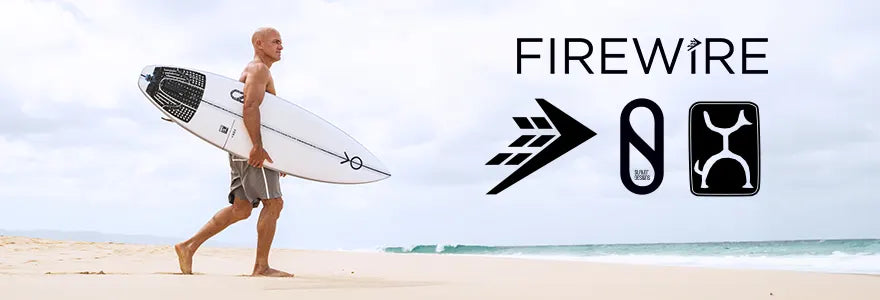Firewire - 5'1 Twice Baked TT (28.3L) Mannkine surfebrett
Dimensjoner: 5'1 x 20 3/4 x 2 1/4 - 28.3 Liter
Finneoppsett: 5-fin FCS II (finner selges separat)
Konstruksjon: Linear Flex Technology
Farge: TimberTek
The Twice Baked is very obviously a squash-tailed little brother to the Baked Potato (See further down)
As far as dimensions go, if you ride a Baked Potato you’re likely to ride the same size Twice Baked. There are rather significant changes to the design overall; most obvious being the tail outline, and then the bottom contour. Like the BP, the TB has a double-barrel concave set within a single concave under the front foot, but it is slightly less aggressive and this time I split a concave into V just ahead of the center fin, or about 6-7” up from the tail. I also smoothed out the deck contours to add to an overall cleaner look.
This board is going to want to be surfed with performance in mind- with your foot all the way back, a low center of gravity, and to be pushed hard through turns, as well as when you are generating speed down the line and through soft sections.
Board Dimensions
| LENGTH | WIDTH | THICKNESS | VOLUME |
|---|---|---|---|
| 5'1" | 20 3/4" | 2 1/4" | 28.3L |
| 5'3" | 21 1/4" | 2 3/8" | 31.6L |
| 5'5" | 21 3/4" | 2 1/2" | 35.2L |
| 5'7" | 22 1/8" | 2 5/8" | 38.6L |
| 5'9" | 22 3/8" | 2 3/4" | 42.0L |
| 5'11" | 22 5/8" | 2 7/8" | 45.7L |
| 6'1" | 22 3/4" | 3" | 49.3L |
| 6'3" | 23" | 3" | 51.3L |
Baked Potato info for reference:
From Surfboard Designer | Dan Mann
The first Baked Potato I ever made was for my buddy Chris in late 2010.
I had been surfing the Sweet Potato which I loved. I literally laughed hysterically after the very first wave I caught on it. I had never gone so fast with so much control on such weak waves ever before.
At Firewire we had been having great success with the Sweet Potato at the time that I made that first Baked Potato. I made it because I thought it could bet more racey and more performance oriented than a Sweet Potato.
It didn’t take long to pull in the nose and refine the bottom a little, and the tail just kind of popped into my head when I realized that point behind the back quad fins can add a bit more of a pivot point.
The Baked Potato sits firmly in the groveler style of a board but the best part about it is when I see people ripping on it in overhead surf which I see all the time. If you ride one, don’t underestimate how well it will go in good surf that’s overhead.
I think most surfers will enjoy this board most as a quad set up with a small nubster in the thruster box.

Firewire

Firewire er dedikert til å heve surfopplevelsen gjennom innovativ design, nye materialer og avanserte byggemetoder.
Hvert eneste surfebrett, tailbad og leash som lages, er designet med ett mål for øye - å forbedre surfopplevelsen så mye som mulig samtidig som produksjonen påvirker miljøet så lite som mulig.
Selv om Firewire nå er et kjent navn i surfebrettverdenen, er det mange mennesker som ikke er klar over at det faktisk har en dyp og rik historie som går tilbake til 1990-tallet. Firewire var faktisk opprinnelig surfebrettmerket Nev, som ble ledet av Neville Hyman, en respektert og produktiv shaper i Western Australia.
Hyman utvidet Nev og skapte Firewire i 2006, ved å bruke maskinell formeteknologi og epoxy sandwich-konstruksjon for å lage noen av de mest høyteknologiske surfebrettene på markedet. Siden den gang har nesten alle respekterte brettmerker gått videre til å adoptere en eller annen form for variasjon av Firewires futuristiske konstruksjonsprosesser. I mellomtiden har Firewire ekspandert globalt, kjøpt opp flere andre merker og lagt til flere av verdens beste surfebrettdesignere og shapere i stallen sin.
Kelly Slater investerte i selskapet for noen år tilbake og integrerte sine Slater Designs-brett i Firewire-familien, noe som brakte shapere som Dan Mann, Akila Aipa og Daniel "Tomo" Thomson til laget. Og Rob Machado har siden blitt med som designer og shaper, og har lagt til sin avslappede estetikk i utvalget.

TIMBERTEK represents a significant step forward towards the holy grail of any product designed and manufactured in today’s environmentally conscious world. While by no means sustainably built, Firewire’s TIMBERTEK has by far one of the least toxic and smallest carbon footprints of any commercially available surfboard today.
The combination of a lightweight EPS core, sustainably-grown Paulownia wood deck skins, Firewire’s proprietary parabolic rail construction, and an Entropy bio-resin hot coat yield an extremely lightweight, durable surfboard with ALL of the high performance flex characteristics of Firewire’s existing technologies.
Even more impressive, the physical properties of the raw materials involved have allowed us to reduce exterior lamination significantly, furthering the reduction of the board’s carbon footprint. Or as we like to describe TIMBERTEK, it’s simply High Performance Art.
PAULOWNIA WOOD DECKSKIN
Paulownia wood is extremely fast growing; up to 20 feet in one year when young. Some species of plantation Paulownia can be harvested for saw timber in as little as five years. Once the trees are harvested, they regenerate from their existing root systems, earning the name of the “Phoenix tree.”



